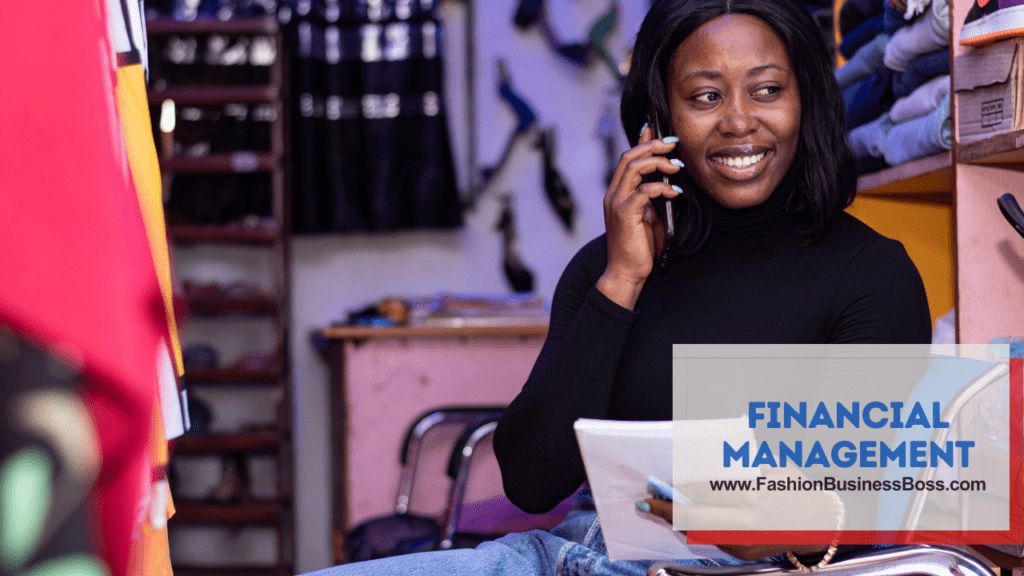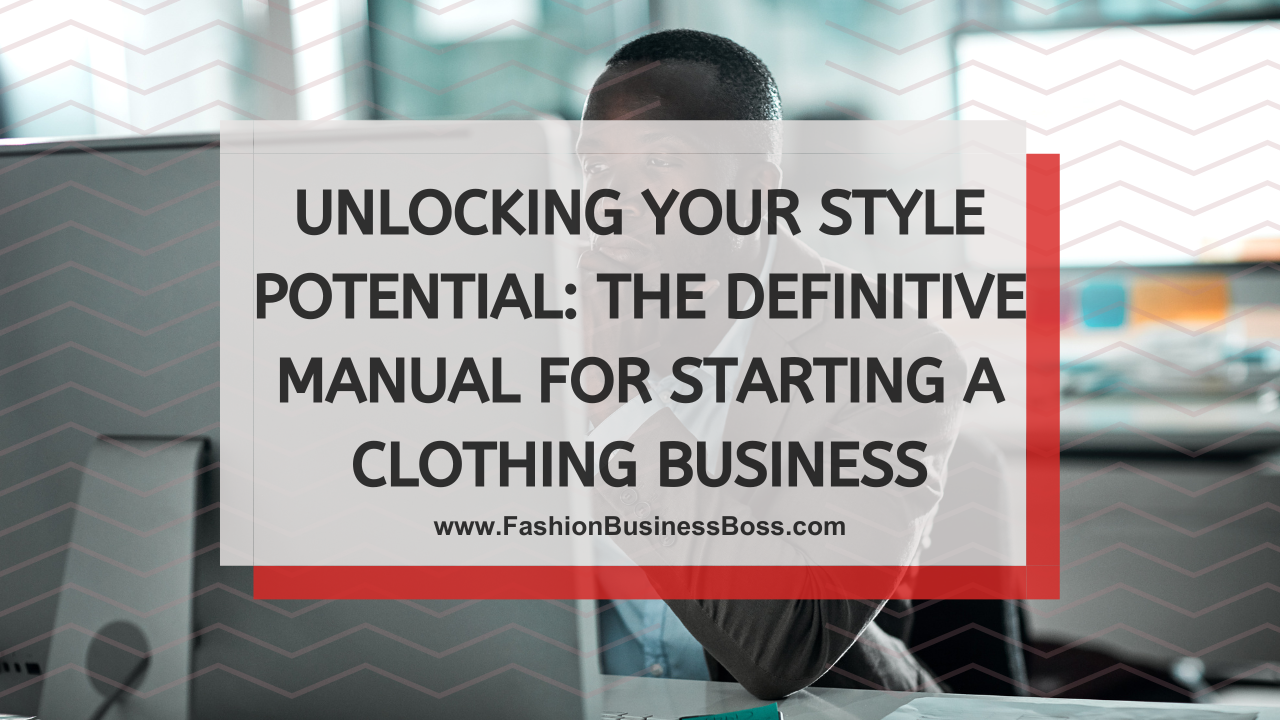Whether you’re passionate about fashion or looking for a great business opportunity, the clothing industry offers a diverse range of niches to explore.
To set up a clothing business, start with market research to identify your niche, create a business plan, register your business, secure funding, source suppliers, design and produce clothing, build an online and/or physical store, and market your brand effectively to attract customers.
This comprehensive guide will walk you through the step-by-step process of setting up a clothing business, from the initial idea to the grand opening of your store.
Define Your Niche and Target Market

Before jumping into the world of clothing retail, it’s vital to figure out your specialty and who you want to sell to. Think about the kind of clothes you’ll offer and who your perfect customers are. Consider things like their age, gender, fashion tastes, and what they’re willing to pay.
To do this right, spend some time looking into the market. Try to spot where there are opportunities and who your competition might be. This means doing some research to learn about what’s already out there and what people want.
By understanding your niche and target audience, you can tailor your clothing business to meet their needs. Maybe you want to create stylish work attire for young professionals, or perhaps you’re all about comfy and affordable clothes for college students. Whatever it is, make sure you have a clear picture of who you’re serving and what sets you apart from others in the market.
Taking this step can save you time and money down the road. It helps you focus your efforts where they’ll be most effective and gives you a better shot at progress in the competitive world of clothing retail.
Read more about: Fashion Sales: Selling Your Clothing Brand
Create a Business Plan
Having a smart business plan is like building a strong base for an adventure. It’s the first step to getting things right. Here’s what you need to do:
First, jot down your goals – what you want your business to achieve. Then, plan out how you’re going to reach those goals. Think about the money stuff too – how much you need, where it’s going, and where it’s coming from.
Include some details about what makes your business special. Who are the people who’ll love what you’re selling? Who else out there is doing something similar? Look at them and figure out what makes you different.
And don’t forget the money part! You’ve got to be clear about how much cash you’ll need to get started and how you’ll price your stuff. Think about how you’ll tell the world about your business too. That’s your marketing plan.
With a good plan, you’ll have a roadmap to follow. It’ll help you make smart decisions and show others that your business is worth investing in. So, take the time to put it all down on paper. It’s a key step in setting up a business that can go places.
Register Your Business
When you’re starting your clothing business, you need to decide on the official way to run it. This is called your business structure. There are a few options, like being a sole proprietorship, forming an LLC, or even going full-on corporation. Each has its pros and cons, so pick the one that suits your business goals and how much risk you want to take on.
After you’ve chosen your structure, it’s time to make it all official. That means registering your business with the right government folks. They need to know you’re in business, and they might want a piece of the action in the form of taxes.
Depending on where you’re located and what you’re selling, you might also need some special licenses or permits. For instance, if you’re running a physical store, you’ll likely need a sales tax permit to legally sell clothing. These rules can vary by location, so it’s essential to check with local authorities to make sure you’re all squared away.
Getting these legalities sorted out is a crucial step in starting your clothing business. It ensures you’re on the right side of the law and can focus on what you do best: selling fabulous clothes!
Secure Funding
Figuring out the money part is a big deal when you’re starting a clothing business. You need to know how much cash you’ll need to get things rolling and keep them going. This covers stuff like buying clothes to sell, paying for a store if you have one, spreading the word about your business, and even paying your future employees.
There are a few ways to get your hands on the money you need. If you’ve got some savings tucked away, that’s a good place to start. But if that’s not enough, you can look into loans from banks or other lenders. Sometimes, there are grants available for small businesses, too. And don’t forget about partners or investors who might want to pitch in and share the risks and rewards with you.
The key here is to be realistic. Make a list of all your startup and ongoing expenses, and then figure out where the money’s coming from. It’s a bit like planning your budget, just on a bigger scale. Once you’ve got your financial plan in place, you’ll have a better idea of how to make your clothing business an achievement without running into money troubles down the road.
Source Suppliers and Inventory

Finding trustworthy suppliers is a vital step in running a clothing business. These are the folks who provide you with the clothes you’ll sell to your customers. There are a few routes you can take.
One way is to team up with wholesalers. They’re like middlemen who buy clothes from manufacturers and sell them to you. It’s a good option if you want to carry a variety of brands and styles.
On the other hand, you can go straight to the source and work with clothing manufacturers. This can be a great choice if you have specific designs in mind or want to create your own clothing line. You’ll need to communicate your ideas clearly and work closely with them to get your products just right.
Whichever path you choose, building strong relationships with your suppliers is key. This ensures they understand your needs, and you can rely on them for timely deliveries and top-notch quality.
Good communication and trust go a long way in making sure your clothing inventory is up to snuff and ready to wow your customers. Take your time in finding the right suppliers, and nurture those partnerships for long-term growth.
Read more about: Fashion’s Bankroll: Unveiling the Pay Scale of Clothing Designers
Design and Produce Clothing (If Applicable)
If your dream is to have your own clothing line, you’ll need to roll up your sleeves and get creative. The first step is to come up with designs for your clothes. This might mean sketching out your ideas, picking the perfect fabrics, and teaming up with manufacturers or skilled seamstresses to bring your vision to life.
Sketching designs is like putting your ideas on paper. It’s where you decide what your clothes will look like, from the overall style to the tiny details. Once you’re satisfied with your designs, it’s time to choose the right fabrics. This is crucial because the materials you pick will affect how your clothes feel and look.
Working with manufacturers or seamstresses is like turning your drawings into real garments. You’ll need their expertise to make sure everything fits together just right. Collaboration is key here – clear communication and teamwork help ensure your designs match what your target customers want.
Remember, your designs should match what your ideal customers love to wear. Keep their preferences in mind to create clothing that’ll make them excited to buy. With hard work, creativity, and attention to detail, you can bring your clothing line to life and make it a hit with your target market.
Set Up Your Store
When it comes to where and how you’ll sell your clothes, you’ve got some choices to make. You can set up shop online, open a physical store, or even do a bit of both.
For an online store, your main focus will be creating a fantastic website. Think of it as your digital storefront. Make sure it looks great with high-quality images of your clothes and detailed descriptions so customers know exactly what they’re getting. A user-friendly and secure e-commerce platform is essential for smooth transactions.
If you’re leaning towards a physical store, location is key. Find a spot where your target customers hang out, and it should match the vibe of your brand. Your store layout and decor should be welcoming and in line with your brand’s style. A well-designed and inviting store can draw customers in and keep them coming back.
Choosing between online, physical, or a combination depends on your business strategy and target market. Some businesses thrive in the online world, while others benefit from the in-person experience. Whatever you choose, make sure it aligns with your brand and helps you reach your customers effectively.
Develop an Online Presence
In this digital era, being online is a must for clothing businesses. You’ve got to make your mark on the internet, and there are a few smart ways to do it.
First up, social media is your friend. Platforms like Instagram, Facebook, and Pinterest are where folks hang out and discover cool stuff. So, show off your clothes there. Share eye-catching pictures, talk about what makes your clothes special, and chat with people who might become your customers.
Another big thing is making sure people can find you when they’re searching online. That’s where SEO comes in. It’s like the secret sauce that helps your website show up when someone Googles “awesome clothes” or whatever you’re selling. So, invest some time and maybe a bit of money into making sure your website ranks well in search results.
Being online isn’t just about selling stuff; it’s also about building a brand and connecting with your audience. So, get social, get seen, and make sure people can find you easily. It’s a big part of making your clothing business a hit in today’s digital world.
Marketing and Branding

Creating a brand that clicks with your customers is super important. It’s like giving your business its personality. Here’s what you need to do:
First, come up with a brand name that’s catchy and memorable. It should tell people something about what you’re all about. Then, design a logo and come up with a cool tagline that sums up your style.
Once you’ve got your brand sorted, it’s time to get the word out there. You can do this in a bunch of different ways. Start by creating interesting content that shows off your clothes and your brand’s personality. Send out emails to your customers to keep them in the loop. Partner up with influencers who can help spread the word. And don’t be shy about using paid ads to reach even more people.
Also, think about going to local events and fashion shows. It’s a great way to meet potential customers face-to-face and give them a taste of your brand in person.
All of these things help build a strong brand that people love. So, make sure your brand is memorable and your marketing strategy is on point. It’s how you’ll stand out in the fashion world and make your clothing business progress.
Read more about: Fashioning a Bright Future: Your Clothing Brand Business Plan
Inventory Management
Managing your inventory wisely is a big deal in the clothing business. You want to make sure you have the right clothes in stock without ending up with a bunch of stuff you can’t sell. That’s where inventory management comes in.
Think of it like this: you’ve got a closet, and you need to keep track of all the clothes in there. You don’t want too many of one thing and not enough of another, right? That’s where inventory management software comes to the rescue. It’s like having a super organized closet that tells you what’s in there and when you should get more of something.
With this software, you can easily see what’s flying off the shelves and what’s not so hot. When it’s time to reorder, you’ll know exactly what you need. Plus, it helps you avoid having a closet full of unsold clothes that just take up space and money.
So, if you want to be smart about your clothing business, get yourself some inventory management software. It’ll keep your stock in check and help you make decisions based on what your customers want.
Pricing Strategies
Getting your prices right is a big deal when you’re running a clothing business. You want to make sure you’re making money, but you also want your customers to feel like they’re getting a good deal. It’s a bit like finding that sweet spot.
Start by thinking about how much it costs to make your clothes. You’ve got to cover those costs and still have some left for yourself. Look at what your competitors are charging too. You don’t want to be way more expensive or way cheaper unless you’ve got a good reason.
Another thing to consider is how your customers see the value of your clothes. If they think your stuff is super high-quality or unique, they might be willing to pay a bit more.
Sometimes, throwing in promotions or discounts can be a good move. It gets people excited about your clothes and can bring in more sales. Just make sure you’re not giving away the farm and hurting your bottom line.
Finding the right prices might take a bit of trial and error, but it’s worth it. You want your customers to feel like they’re getting a great deal, and you want your business to make a profit. So, balance is the name of the game when it comes to pricing strategies in the clothing business.
Provide Exceptional Customer Service
Providing top-notch customer service can be a game-changer for your clothing business. It’s like building a group of loyal fans who keep coming back for more and even tell their friends about you.
Here’s the deal: when customers have questions or concerns, be quick to respond. Nobody likes waiting around for answers. Be friendly and helpful. Make them feel heard and important.
If someone isn’t happy with their purchase, be cool about it. Offer hassle-free returns and exchanges. It’s like saying, “Hey, we want you to be happy with what you got.” When you’re easy to deal with, customers are more likely to shop with you again.
Happy customers are your best promoters. They’ll tell their friends and family about your business, and word-of-mouth recommendations are gold in the world of retail.
Financial Management

Keeping a sharp watch on your money matters is a must for your clothing business. It’s like looking at your bank balance and making sure everything adds up.
Start by keeping good records. Write down every dollar that comes in and goes out. This helps you see where your money is going and if you’re making more than you’re spending.
Tracking expenses is super important too. It’s like watching your spending habits in your personal life. Make sure you’re not splurging on things that don’t help your business grow.
Cash flow is another biggie. It’s like checking your bank account regularly to see if you have enough money to cover your bills and buy more clothes. If you’re running low on cash, you might need to make some adjustments.
Also, remember your business plan? Don’t just set it aside after you start. Check in on it regularly. It’s like your roadmap. If things aren’t going as planned, you might need to tweak your strategies to get back on track.
Read more about: Fashion Entrepreneur’s Handbook: Launch Your Clothing Brand with Confidence
Scale and Expand
As your clothing business takes off and grows, it’s a good idea to think about spreading your wings a bit. You’ve got a few exciting options on the table.
First, you can expand the kinds of clothes you offer. Maybe you started with just T-shirts, but now you’re thinking about adding jeans, dresses, or accessories. This can bring in more customers and keep your existing ones interested.
Opening more store locations is another possibility. If you’re doing well in one place, why not try your luck in another? Just make sure you do your homework and pick spots where your target customers hang out.
And there’s always the option to enter new markets. If you’re selling locally, think about going online or even selling internationally. It can open up a whole world of opportunities.
But here’s the thing: you’ve got to stay in the loop. Keep an eye on what’s hot in the fashion world and what your customers are into. Trends change, and so do people’s tastes. Adapting to what’s happening is the key to staying competitive.
Seek Professional Advice
When you’re running a clothing business, it’s okay to ask for help. It’s a smart move. Don’t be shy about seeking advice from folks who know the ropes in the fashion and retail world.
Experts and mentors in the industry have been around the block. They’ve seen the trends come and go, and they’ve learned what works and what doesn’t. So, don’t hesitate to pick their brains for valuable insights.
They can guide you on tricky decisions, like what clothes to stock or how to market your brand. Plus, they might introduce you to useful connections in the business. Networking is like making friends who can open doors for you.
Having a mentor or getting advice from experts is like having a trusted compass on your journey. They can help you navigate the twists and turns of the fashion and retail world.
So, if you ever feel stuck or unsure, remember, there are folks out there who’ve been there and done that, and they’re usually more than willing to lend a hand. It’s a great way to get your clothing business on the growth path.
Summary
Setting up a clothing business requires careful planning, dedication, and a deep understanding of your niche and target market. By following these steps and staying committed to delivering quality products and exceptional customer service, you can turn your clothing business idea into a sustainable venture.
Stay focused on your goals, continuously learn from your experiences, and adapt to the ever-evolving fashion landscape. With determination and the right strategies, your clothing business can become a thriving enterprise in the competitive world of fashion retail.
Frequently Asked Questions

1. How much money do I need to start a clothing business?
To start a clothing business, you’ll need varying amounts based on your niche and scale. Small online ventures might begin with a few thousand dollars, while boutiques or brands may require tens of thousands for inventory, marketing, and store setup.
2. What are the best marketing strategies for a clothing business?
Effective marketing strategies include social media promotion, influencer collaborations, content marketing, email campaigns, and participating in local events or fashion shows. The right mix depends on your target audience and budget.
3. How do I find reliable clothing suppliers?
You can find clothing suppliers through trade shows, online directories, industry associations, or by directly contacting manufacturers. Always vet potential suppliers for quality, reliability, and pricing before committing to a partnership.
To learn more about starting your own clothing business, check out my startup documents here.
The information provided by FashionBusinessBoss.com (“The Site”) is for general informational purposes only. All information on the Site is provided in good faith, however, we make no representation or warranty of any kind, express or implied, regarding the accuracy, adequacy, validity, reliability, availability or completeness of any information on the Site. Under no circumstance shall we have any liability to you for any loss or damage of any kind incurred as a result of the use of the Site or Reliance on any information provided on the Site. Your use of the Site and your reliance on any information on the Site is solely at your own risk. This blog post is for educational purposes only and does not constitute legal advice. Please consult a legal expert to address your specific needs. Terms and Conditions. (https://fashionbusinessboss.com/terms-and-conditions/)

Meet Shawn Chun: Entrepreneur and Fashion Business Fan.
I’m a happy individual who happens to be an entrepreneur. I have owned several types of businesses in my life from a coffee shop to an import and export business to an online review business plus a few more and now I create online resources for those interested in starting new ventures. It’s demanding work but I love it. I do it for those passionate about their business and their goals. That’s why when I meet a designer or boutique owner at a craft fair, farmers market, retail location or anywhere else I see myself. I know how hard the struggle is to retain clients, find good employees and keep the business growing all while trying to stay competitive.
That’s why I created Fashion Business Boss: I want to help fashion business owners like you build a thriving business that brings you endless joy and supports your ideal lifestyle.

